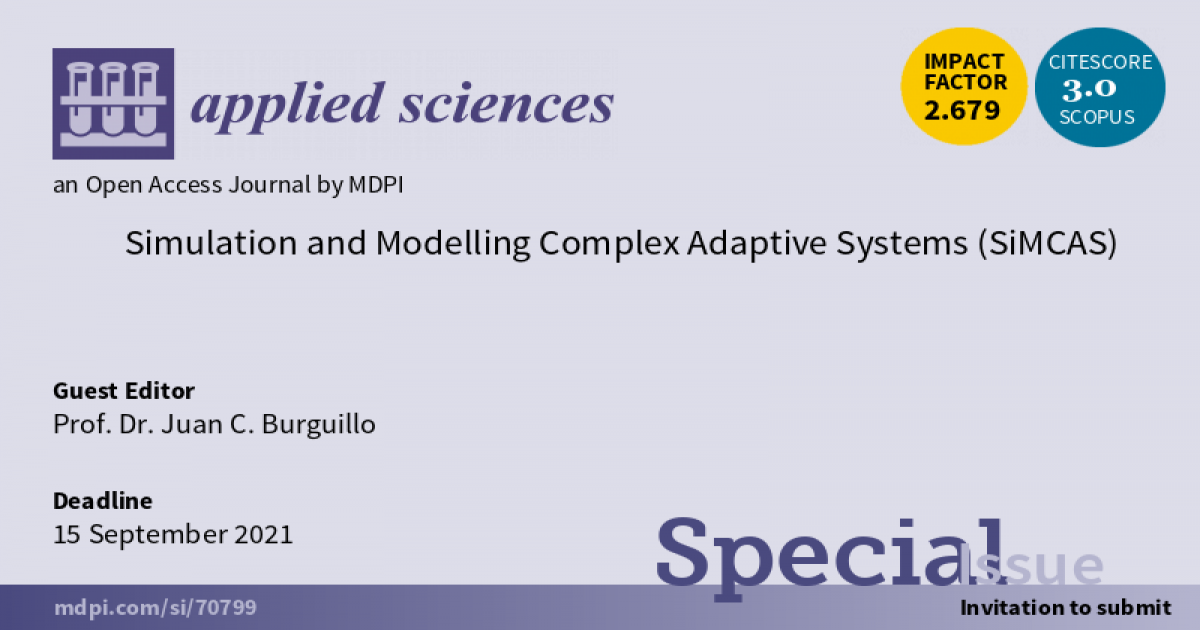Simulation and Modelling Complex Adaptive Systems (SiMCAS)
A special issue of Applied Sciences (ISSN 2076-3417). This special issue belongs to the section "Computing and Artificial Intelligence".
Deadline for manuscript submissions: closed (15 September 2021) | Viewed by 660
Deadline for 2-page abstract submissions: 15 June 2021.

Special Issue Editor
Special Issue Information
Dear Colleagues,
Nowadays, the ICT ecosystem has achieved a huge complexity thanks to the emergent scenarios driven by new technologies like sensor networks, 5G, traffic management, Internet of Things (IoT), machine learning, digital and green economy, smart cities, intelligent transportation systems, crowdsourcing and cybersecurity, among others. The huge amount of entities interacting in such systems, the relative unpredictability of their dynamic organization, and the emergence of new technological opportunities make it really difficult to predict future economic and technologic scenarios in order to optimize human activities for the common good.
A complex adaptive system (CAS) is complex in the sense that contains multiple and diverse interconnected elements with a high degree of adaptive capacity, which makes the system resilient against disturbances. CAS systems usually show characteristic properties, such as self-similarity, emergence and self-organisation. Recently, the research community has accomplish a strong effort to study natural and artificial CAS, and presently we are beginning to understand the emergent patterns of global organisation, and finding that apparently very dissimilar systems share fundamental commonalities.
Trying to model a large number of entities, with non-linear interactions in a continuously changing environment, by means of classical mathematical tools has become a very hard task. Within this context, computer simulations emerged as the natural tool for performing such kind of analysis and evaluation. The CAS system resulting from the interactions among the agents is usually modelled as an Agent-based System (ABS), or a Multi-agent System (MAS), and such models have been strongly used in the last two decades to describe and simulate CAS by means of Agent-based Simulations (ABS). The aim of these agent-based models and simulations is to better understand real CAS scenarios, analysing their properties, strengths, weaknesses and limitations; but also to consider alternative scenarios, in order to explore new possible solutions to the present problems, and to discard inappropriate paradigms, assumptions or models.
In the past decades, the research community has made a huge effort to understand and simulate CAS, but we are still far away from delivering well-defined frameworks to support their design, engineering, management, and evaluation. However, before we can do that, we will still have to develop new theories that shed more light on CAS definition, representation, dynamics, sensitivity analysis, verification, and validation.
These are the topics addressed in this Special Issue titled “Simulation and Modelling for Complex Adaptive Systems”. Authors are invited to submit a paper on one or more of the non-exhaustive list of potential topics of interest, including the following:
- Agent-based modelling and simulation
- Hierarchical- and coalition-based complex adaptive systems
- Cellular automaton modelling and simulation
- Complex networks, social networks, and social media analysis
- Self-organization and emergence
- Evolutionary game theory for simulating complex adaptive systems
- Artificial societies and social simulation
- Bioinformatics and bio-inspired paradigms
- Computational Intelligence: deep learning and machine learning
- Computational game-theoretic analysis of financial scenarios: markets, digital economy, blockchain, etc.
- Artificial intelligence techniques for financial systems simulation
- Clean energy and green power systems
- Smart cities and smart homes
- Intelligent transport systems and automotive industry
- Artificial intelligence and crowdsourcing
- Artificial intelligence and cybersecurity
- Artificial Intelligence techniques for communication networks: sensor networks, 5G, Internet of Things (IoT)
- Surveys on the above topics.
Prof. Dr. Juan C. Burguillo
Guest Editor
Manuscript Submission Information
Manuscripts should be submitted online at www.mdpi.com by registering and logging in to this website. Once you are registered, click here to go to the submission form. Manuscripts can be submitted until the deadline. All submissions that pass pre-check are peer-reviewed. Accepted papers will be published continuously in the journal (as soon as accepted) and will be listed together on the special issue website. Research articles, review articles as well as short communications are invited. For planned papers, a title and short abstract (about 100 words) can be sent to the Editorial Office for announcement on this website.
Submitted manuscripts should not have been published previously, nor be under consideration for publication elsewhere (except conference proceedings papers). All manuscripts are thoroughly refereed through a single-blind peer-review process. A guide for authors and other relevant information for submission of manuscripts is available on the Instructions for Authors page. Applied Sciences is an international peer-reviewed open access semimonthly journal published by MDPI.
Please visit the Instructions for Authors page before submitting a manuscript. The Article Processing Charge (APC) for publication in this open access journal is 2400 CHF (Swiss Francs). Submitted papers should be well formatted and use good English. Authors may use MDPI's English editing service prior to publication or during author revisions.
Benefits of Publishing in a Special Issue
- Ease of navigation: Grouping papers by topic helps scholars navigate broad scope journals more efficiently.
- Greater discoverability: Special Issues support the reach and impact of scientific research. Articles in Special Issues are more discoverable and cited more frequently.
- Expansion of research network: Special Issues facilitate connections among authors, fostering scientific collaborations.
- External promotion: Articles in Special Issues are often promoted through the journal's social media, increasing their visibility.
- e-Book format: Special Issues with more than 10 articles can be published as dedicated e-books, ensuring wide and rapid dissemination.
Further information on MDPI's Special Issue policies can be found here.





